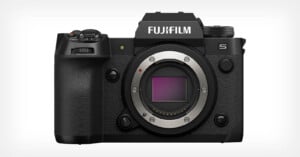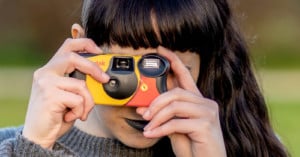
Fujifilm GF 55mm f/1.7 R WR Review: Astonishing Image Quality
Last fall, Fujifilm unveiled its newest medium format camera, the Fujifilm GFX 100 II along with its first tilt-shift lenses and a new fast prime: the Fujifilm GF 55mm f/1.7 R WR.
Matt Williams is a writer, photographer, and filmmaker, currently residing outside of Nashville, TN. He is passionate about the science, art, and history of photography. He is a fan of Paul Newman, Ingmar Bergman films, rare and unique lenses, fruit (not raspberries), and telling people on the Internet they’re wrong. Some of his favorite photographers are Saul Leiter, Berenice Abbott, Gregory Crewdson, Edward Weston, Imogen Cunningham, and William Eggleston. Someday he’d like to work for Zeiss or Leica and promises to learn German if that happens. He is working on several photo projects and might finish them someday.

Last fall, Fujifilm unveiled its newest medium format camera, the Fujifilm GFX 100 II along with its first tilt-shift lenses and a new fast prime: the Fujifilm GF 55mm f/1.7 R WR.

I’m not just a camera history nerd, I’m also a huge fan of weird things in general. Weird and unique technology is especially fascinating, and I’m sure many readers here share the same sentiment.

My first digital ILC (interchangeable lens camera) was the Nikon D40, which I purchased during my senior year of high school in late 2007. That camera was followed by the Canon T2i (550D), which I bought in 2010, primarily because of Canon’s significantly more advanced video features; I have always been an active filmmaker as well as a photographer. Like most people, my first two lenses for each of these cameras were the kit 18-55mm zoom and a cheap nifty-fifty prime lens, so the cost of switching systems wasn’t exactly high.

I have always admired Sigma. It wasn’t regarded in the same league as it is today for its lenses until the Art series came out, but Sigma’s digital cameras have always been singular in design and purpose. The family-owned company has never been afraid to try something new, and honestly, that’s something we need to see a lot more of in the photography world.

One of the best things I’ve purchased as a photographer (and videographer) was an editing console. I own probably eight at this point, all with their own purposes and advantages.

Merriam-Webster defines “retro” as “fashionably nostalgic or old-fashioned.” With the rise in popularity of shooting on film over the past few years and the extraordinary success of instant cameras among the general populace, I think it is fair to say that retro cameras are likewise lusted after by many.

I write about a lot of things here at PetaPixel -- reviews, guides, technical articles, opinion pieces -- but one of my favorite topics to write about is the history of photography. As an avid user and collector of vintage cameras and lenses, I have passionately absorbed as much knowledge about their history as possible over many years. Like studying world history, there is much value in understanding where we came from and what got to us where we are now.

We don’t often extensively cover video gear here at PetaPixel, but we thought it might be helpful to cover some of the best hybrid cameras out there -- those cameras geared toward both photographers and videographers.

The compact camera, also known colloquially as the point-and-shoot camera, has been a staple of the photography world for over a century. Perhaps the first mass-market compact camera was introduced in 1900 by Eastman Kodak, costing a mere one dollar (about $36 today).

Photographic printing was once a widespread and vital art form in itself. While there were (and are) various techniques for producing prints from film, the most common in the film era was the use of light-sensitive paper and an enlarger -- the paper would be exposed to a film negative or positive transparency (slide film) via the enlarger in a darkroom, or a digital exposure unit such a minilab machine, which you used to find in just about every drugstore.

Cameras all have a pretty solid set of features and design elements that appeal to a wide range of users. But, for the most part, pretty much all of them lack a set of features that would make them all a lot more powerful and enjoyable to use.

The Meyer Optik Görlitz 35mm f/2.8 Trioplan II is a unique lens that performs its best when the bokeh is specifically integrated into a shot and not just a coincidence of the defocus area. That means it's not for everyone, but it has its place.

Film is back, and with its booming popularity, there are a lot of options to try. These are our top picks for the best 35mm film you can find today for a range of use cases.

I've been using the Panasonic GH6 for a few months so we could provide a long-term review for what was once a hotly-anticipated successor to the very popular GH5.

Venus Optics has introduced yet another unique lens to the market: the Laowa Argus 25mm f/0.95 APO for Micro Four Thirds. As a long-time user of the Micro Four Thirds system, I jumped at the opportunity to test drive this lens after I heard “0.95” and “APO” in the same sentence.

Once a staple of photography for the general populace, disposable (or “single-use”) cameras have become something of a niche -- most people who never stopped shooting film or those younger audiences who are coming to it for the first time choose to use an affordable SLR or point and shoot camera. The image quality is quite superior and a single roll of film is less expensive (though typically not by much) than a disposable camera.

Photoshop and Lightroom are mainstays in most photographers’ workflows for a reason. While other options abound, no other set of programs matches the popularity and widespread adoption of Adobe’s signature photography software. But while Photoshop’s manipulation capabilities and Lightroom’s processing and editing power are certainly robust, both offer even more power beyond the software itself in the form of plugins.

If you’re a photographer, you’re likely familiar with memory cards. They’re what our photographs are stored on -- removable flash media that we insert into a slot (or slots) in our camera, take photos, and then (sometimes) remove and insert into a card reader or card slot on our computer.

I’ve been an Olympus and Micro Four Thirds user since I purchased a used E-M5 in 2016. I love Olympus, and like many others was sad to hear the news when the company’s photo division came to an end. There was a lot of speculation and anxiety over what JIP would do with the business, but the rebranding to OM Digital encouraged confidence. Since then, I have eagerly awaited the new company’s first camera. And now we have it: the OM System OM-1.

We can spend hours poring over buying guides and recommendations for the fanciest, most expensive pieces of kit to complete our bag as photographers, but in all that excitement, there is one crucial piece of our arsenal that can be overlooked. It hardly qualifies as a bell or a whistle and no one will drool with envy at the sight of it, but it is absolutely one of the most important purchases you will make: the camera strap.

Vintage lenses are more popular than ever, thanks in large part to the mirrorless revolution as well as affordable, high-quality cinema and hybrid video cameras. These lenses are regularly “cine modded” for video use due to their unique character and less clinical rendering, (sometimes) affordable prices compared to cine lenses, helicoid-driven focus with hard stops, and physical aperture rings (which are often de-clicked).

While visiting a friend recently, I noted that his teenage daughter’s walls were lined with Polaroids of her and her friends. I expressed some surprise and inquired about what got her interested in instant photography. She tilted her head and smirked at the question, and I soon understood why. The term “instant photography” struck her as curiously redundant.

Looking to get started in photography but feel overwhelmed at the huge number of different camera models on the market? The daunting feeling can be an obstacle as you try to dive headfirst into the art form, but you have come to the right place: we have selected the best cameras for beginners looking to dip their toes in photography without breaking the bank or getting in over their heads.

The past decade has seen an explosion of film users. Whether this is driven by a sense of nostalgia, or a desire to experience the past (for those too young to have shot film earlier in their life), for the simplicity, or perhaps because some celebrities have taken to shooting film, it doesn’t really matter. The reality is likely a combination of many factors.

While there are many advantages to buying a brand new camera -- including a manufacturer warranty and, well, the fact that it’s never been used by anyone else -- there are likewise a plethora of reasons to buy cameras on the used market.

It is very common to hear the term "1-inch sensor" and based on the name, it would be natural to assume that at least part of it is 1-inch in size. Except that's not the case.

We exist in a constantly churning sea of content: there were 1.4 trillion photos taken in 2021 and an estimated 1.6 trillion shutter buttons will be pressed this year. With so many taken, where is the best place to share photos?

Leica has finally officially revealed the M11 Rangefinder, letting us finally put all the rumors of what we may or may not expect to rest. Now that it's here, what has five years of development given us?

Film has experienced a bit of a resurgence in the past decade and we've seen a proliferation of never-before-made film stocks and even brought some back from the dead. But if you want to get started in film photography now, you'll need a camera. So where should you start?

While full-frame has received the most attention from camera manufacturers in recent years, there are plenty of great reasons to purchase smaller format sensors like APS-C. These systems can be cheaper, smaller, lighter, and offer greater reach over their full-frame counterparts.

Ever since I became a photographer, most of the cameras and lenses I have purchased have been used. Most cameras and lenses only come with one-year warranties (though there are exceptions), and since some used gear sellers offer 6-month warranties, that extra half-year is often not worth the difference (to me). And, of course, some items -- like vintage or discontinued cameras and lenses -- are only available used.

One of the most exciting advancements in digital photography over the last several years has been the rapid increase in the ability to shoot and edit RAW photos.

As cameras have rapidly evolved over the last decade, so have the requirements to get the most out of them. Specifically, what a photographer should care about when it comes to a computer has gone from simple, to somewhat complicated and often nuanced.

As an art form and a technology, photography’s youth is only matched by its blisteringly rapid advancement. This creates something of a paradox for us as enthusiasts and professionals, where the history of the medium we so love can feel both short and overstuffed. Neither condition is conducive to any one camera gaining, let alone maintaining, a sense of permanence or constancy.

From importing, to organizing, to the editing process itself, few tools have the capacity to define a photographer’s workflow like Adobe’s Lightroom. Of the program’s many indispensable features, the ability to create user presets ranks quite high: it offers photographers the ability to lock in preferred looks, adjustments, and settings for rapid implementation across multiple images. Better still, these presets are readily shareable, allowing users easy access to the settings required for virtually any desired result without going through the hassle of creating them themselves.

The Leica Freedom Train was not a physical coal or steam engine, but the monumental effort of the Leitz family. This is how they and the Leica camera company saved hundreds of Jews from persecution at the hands of the Nazis.

Over the last fifteen years, physical photography has become a rarity, even a luxury, for the everyday citizen. Modern cell phones have provided average folks with all the camera power they could ever need. Social media has rendered the storage and sharing of visual memories a strictly online affair. As with most recent innovations, the price for increased accessibility has been paid for in tangibility. What was once common has become quaint, what was universal is now bespoke.

Thanks to the smartphone camera, we can capture any memory we choose, at any time, but they’re more vulnerable -- and temporary -- than ever, but they all feel more temporary than ever. This is the modern paradox.

Seasoned photographers know that the search for the right laptop comes down to far more than a list of individually impressive specs. The perfect laptop for photo editing will not always be the one with the most bells and whistles, because perfection here is about so much more: usability, ease, intuition -- all the things that combine to create not just powerful imagery, but a powerful workflow as well.

Just after the Christmas of 1904, a group of lucky children nestled into their seats at the Duke of York’s Theatre in London for a night of whimsy and wonder. There, they witnessed the first adventure of a boy who could never grow up, clad in autumn leaves and cobwebs. Their eyes expanded with delight as he entered the room of children just like them, on a mission to retrieve a friend.